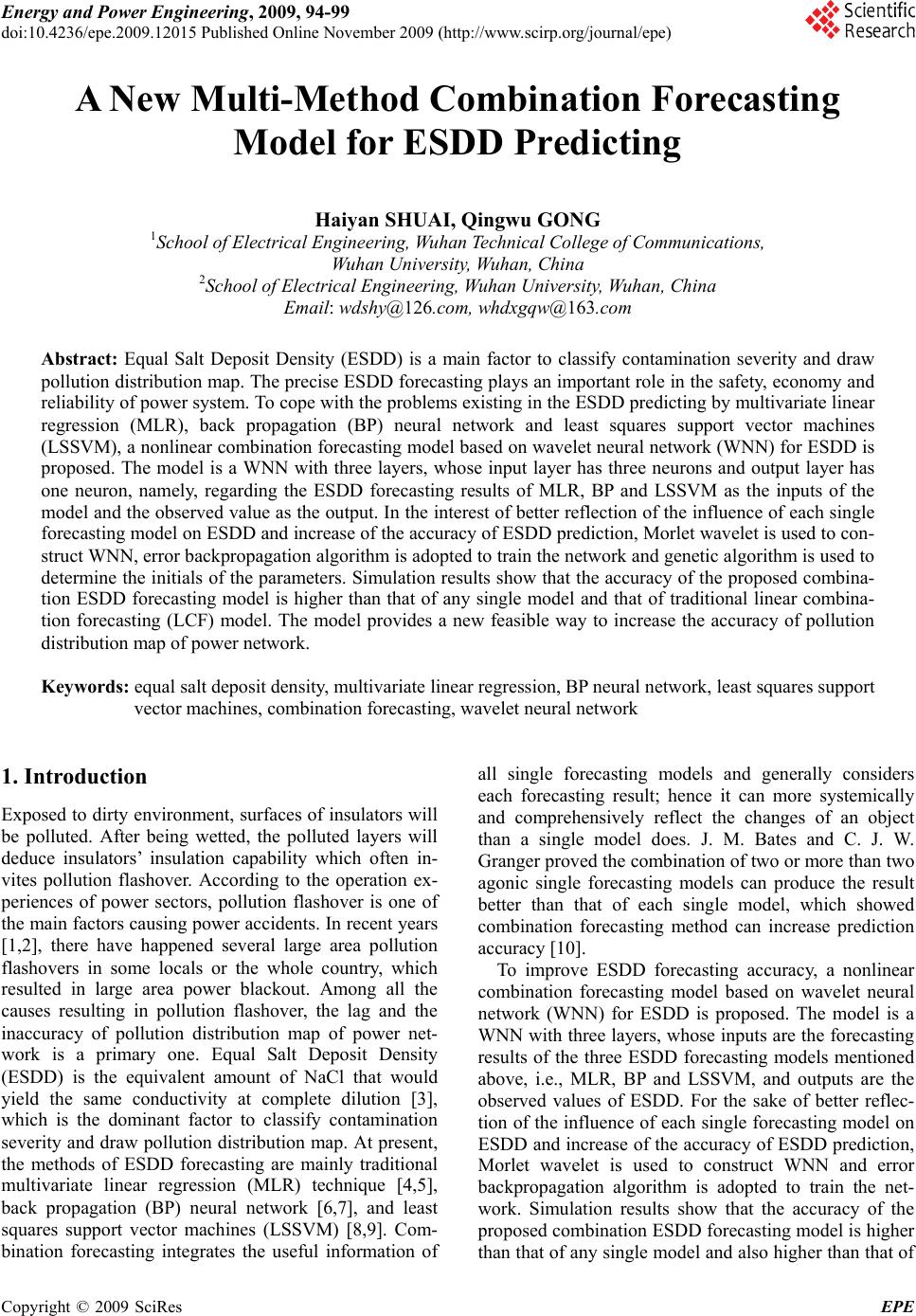 Energy and Power Engineering, 2009, 94-99 doi:10.4236/epe.2009.12015 Published Online November 2009 (http://www.scirp.org/journal/epe) Copyright © 2009 SciRes EPE A New Multi-Method Combination Forecasting Model for ESDD Predicting Haiyan SHUAI, Qingwu GONG 1School of Electrical Engineering, Wuhan Technical College of Communications, Wuhan University, Wuhan, China 2School of Electrical Engineering, Wuhan University, Wuhan, China Email: wdshy@126.com, whdxgqw@163.com Abstract: Equal Salt Deposit Density (ESDD) is a main factor to classify contamination severity and draw pollution distribution map. The precise ESDD forecasting plays an important role in the safety, economy and reliability of power system. To cope with the problems existing in the ESDD predicting by multivariate linear regression (MLR), back propagation (BP) neural network and least squares support vector machines (LSSVM), a nonlinear combination forecasting model based on wavelet neural network (WNN) for ESDD is proposed. The model is a WNN with three layers, whose input layer has three neurons and output layer has one neuron, namely, regarding the ESDD forecasting results of MLR, BP and LSSVM as the inputs of the model and the observed value as the output. In the interest of better reflection of the influence of each single forecasting model on ESDD and increase of the accuracy of ESDD prediction, Morlet wavelet is used to con- struct WNN, error backpropagation algorithm is adopted to train the network and genetic algorithm is used to determine the initials of the parameters. Simulation results show that the accuracy of the proposed combina- tion ESDD forecasting model is higher than that of any single model and that of traditional linear combina- tion forecasting (LCF) model. The model provides a new feasible way to increase the accuracy of pollution distribution map of power network. Keywords: equal salt deposit density, multivariate linear regression, BP neural network, least squares support vector machines, combination forecasting, wavelet neural network 1. Introduction Exposed to dirty environment, surfaces of insulators will be polluted. After being wetted, the polluted layers will deduce insulators’ insulation capability which often in- vites pollution flashover. According to the operation ex- periences of power sectors, pollution flashover is one of the main factors causing power accidents. In recent years [1,2], there have happened several large area pollution flashovers in some locals or the whole country, which resulted in large area power blackout. Among all the causes resulting in pollution flashover, the lag and the inaccuracy of pollution distribution map of power net- work is a primary one. Equal Salt Deposit Density (ESDD) is the equivalent amount of NaCl that would yield the same conductivity at complete dilution [3], which is the dominant factor to classify contamination severity and draw pollution distribution map. At present, the methods of ESDD forecasting are mainly traditional multivariate linear regression (MLR) technique [4,5], back propagation (BP) neural network [6,7], and least squares support vector machines (LSSVM) [8,9]. Com- bination forecasting integrates the useful information of all single forecasting models and generally considers each forecasting result; hence it can more systemically and comprehensively reflect the changes of an object than a single model does. J. M. Bates and C. J. W. Granger proved the combination of two or more than two agonic single forecasting models can produce the result better than that of each single model, which showed combination forecasting method can increase prediction accuracy [10]. To improve ESDD forecasting accuracy, a nonlinear combination forecasting model based on wavelet neural network (WNN) for ESDD is proposed. The model is a WNN with three layers, whose inputs are the forecasting results of the three ESDD forecasting models mentioned above, i.e., MLR, BP and LSSVM, and outputs are the observed values of ESDD. For the sake of better reflec- tion of the influence of each single forecasting model on ESDD and increase of the accuracy of ESDD prediction, Morlet wavelet is used to construct WNN and error backpropagation algorithm is adopted to train the net- work. Simulation results show that the accuracy of the proposed combination ESDD forecasting model is higher than that of any single model and also higher than that of 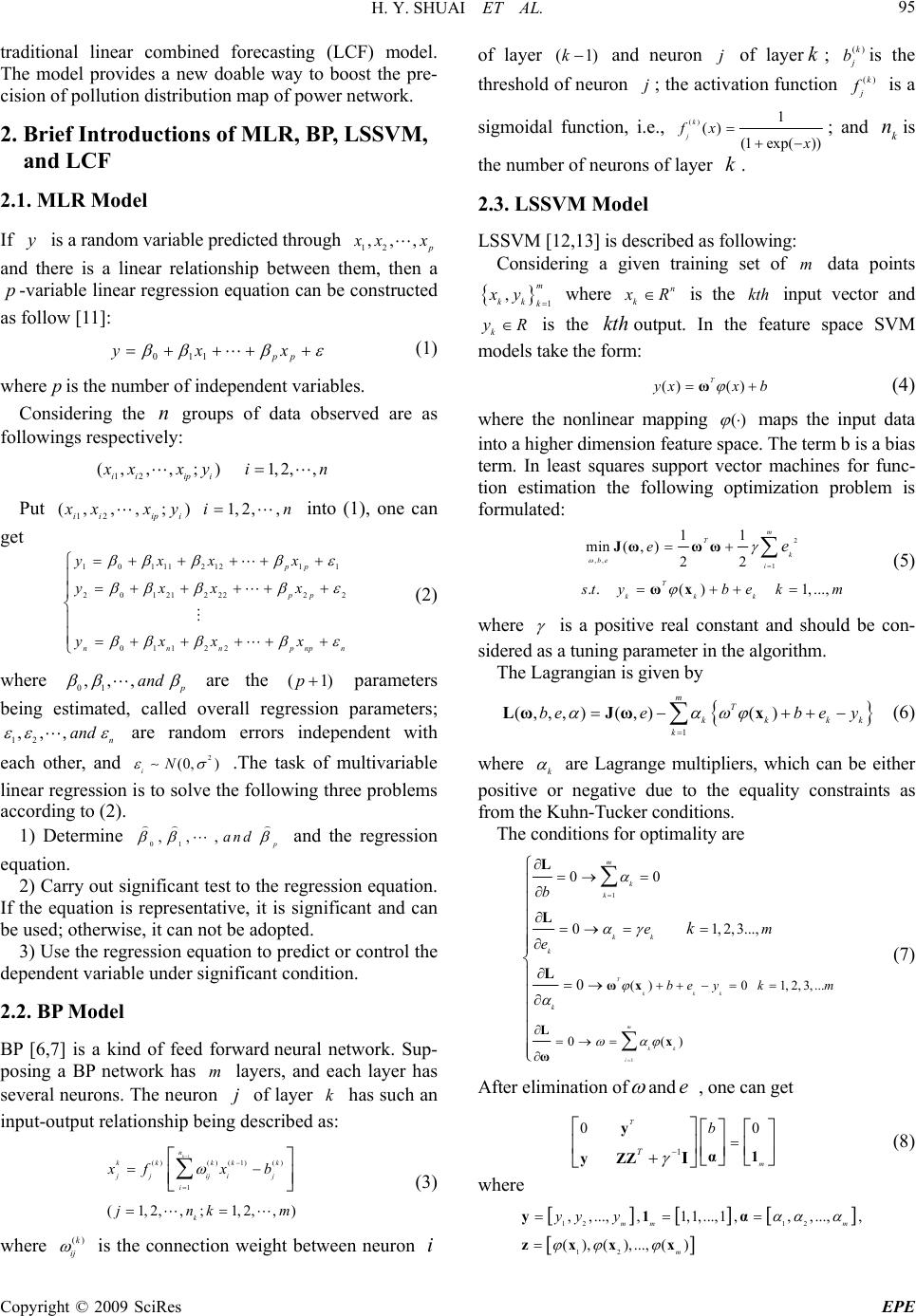 H. Y. SHUAI ET AL. 95 traditional linear combined forecasting (LCF) model. The model provides a new doable way to boost the pre- cision of pollution distribution map of power network. 2. Brief Introductions of MLR, BP, LSSVM, and LCF 2.1. MLR Model If is a random variable predicted through y12 ,,, xx and there is a linear relationship between them, then a -variable linear regression equation can be constructed as follow [11]: p 011 pp yx x (1) where is the number of independent variables. p Considering the groups of data observed are as followings respectively: n 12 (,,, ;)1,2,, ii ipi xxyin Put 12 (,,, ;)1,2,, ii ipi xxyi n n into (1), one can get 101112121 1 201212222 2 01122 pp pp nnnpnp yxx x yxxx yxx x (2) where 01 ,,, and ,n and are the parameters being estimated, called overall regression parameters; (1)p 12 ,, (0, iN are random errors independent with each other, and 2) .The task of multivariable linear regression is to solve the following three problems according to (2). 1) Determine 01 ,,, and m and the regression equation. 2) Carry out significant test to the regression equation. If the equation is representative, it is significant and can be used; otherwise, it can not be adopted. 3) Use the regression equation to predict or control the dependent variable under significant condition. 2.2. BP Model BP [6,7] is a kind of feed forward neural network. Sup- posing a BP network has layers, and each layer has several neurons. The neuron of layer has such an input-output relationship being described as: m jk 1 ()() ( 1)() 1 1, 2,,1, 2,, k n kkkk k jjijij i k xfx b jnk (3) where ()k ij is the connection weight between neuron of layer i (1)k and neuron of layer; is the threshold of neuron k()k j b ; the activation function )(k j is a sigmoidal function, i.e., () 1 ()fx (1 exp( k j)) k ; and is the number of neurons of layer . k n 2.3. LSSVM Model LSSVM [12,13] is described as following: Considering a given training set of m data points ,m kk k xy 1 where n k R is the input vector and kth k yR is the output. In the feature space SVM models take the form: kth ()yx b()x T ω (4) where the nonlinear mapping () maps the input data into a higher dimension feature space. The term b is a bias term. In least squares support vector machines for func- tion estimation the following optimization problem is formulated: 2 ,, min . . be 1 ( ( ) m T k i T kkk 11 22 , )e 1,..., ty ek e b m Jωω x ω ω (5) where is a positive real constant and should be con- sidered as a tuning parameter in the algorithm. The Lagrangian is given by k y T 1 (,(( ) m kk k ,, )be ,)e k b e LωJωx (6) where k are Lagrange multipliers, which can be either positive or negative due to the equality constraints as from the Kuhn-Tucker conditions. The conditions for optimality are 1 () 0( 00 kk x 1 0 1, .., T kk m kk i m k be k b em e k ω L x ω L 2,3,... ) 1, 2, y 0 0 k k k L L 3. k m (7) After elimination of and , one can get e 1 0 T m y 1 yZ I 0 T Z b α (8) where 1 12 1,1,. , ),() m y x 12 , ,..., (), ( yy zx 2 ,...,, ..., mm y1 x ..,1, α, m Copyright © 2009 SciRes EPE 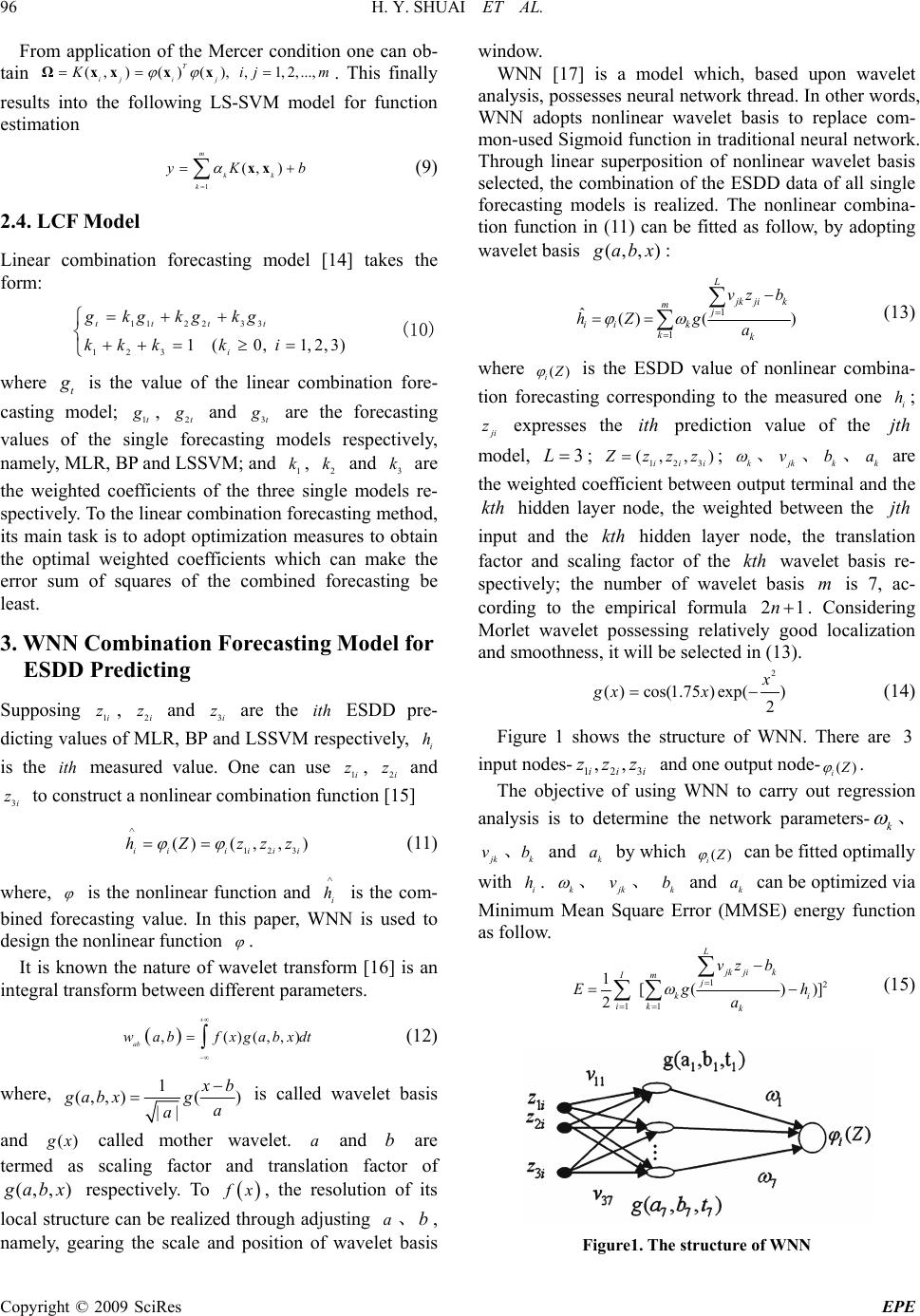 H. Y. SHUAI ET AL. 96 From application of the Mercer condition one can ob- tain (,)()(),,1, 2,..., T iji j ij m Ωxxx x. This finally results into the following LS-SVM model for function estimation 1 (, ) m kk k yK xx b (9) 2.4. LCF Model Linear combination forecasting model [14] takes the form: 112233 123 1(0,1, 2, 3) tttt i gkgkg kg kkkk i (10) where t is the value of the linear combination fore- casting model; 1t , 2t and 3t are the forecasting values of the single forecasting models respectively, namely, MLR, BP and LSSVM; and , and are the weighted coefficients of the three single models re- spectively. To the linear combination forecasting method, its main task is to adopt optimization measures to obtain the optimal weighted coefficients which can make the error sum of squares of the combined forecasting be least. 1 k2 k3 k 3. WNN Combination Forecasting Model for ESDD Predicting Supposing , and are the ESDD pre- dicting values of MLR, BP and LSSVM respectively, is the measured value. One can use , and to construct a nonlinear combination function [15] 1i z2i z3i zith i h ith 1i z2i z 3i z 123 ()( ,,) ii iiii hZ zzz (11) where, is the nonlinear function and is the com- bined forecasting value. In this paper, WNN is used to design the nonlinear function i h . It is known the nature of wavelet transform [16] is an integral transform between different parameters. ,()(,,) ab wab fxgabxdt (12) where, 1 (,,)( ) || b gabxg a a is called wavelet basis and () x ,) called mother wavelet. and are termed as scaling factor and translation factor of ab (, abx respectively. To x, the resolution of its local structure can be realized through adjusting 、, namely, gearing the scale and position of wavelet basis window. ab WNN [17] is a model which, based upon wavelet analysis, possesses neural network thread. In other words, WNN adopts nonlinear wavelet basis to replace com- mon-used Sigmoid function in traditional neural network. Through linear superposition of nonlinear wavelet basis selected, the combination of the ESDD data of all single forecasting models is realized. The nonlinear combina- tion function in (11) can be fitted as follow, by adopting wavelet basis (,,) abx : 1 1 ˆ() () L ji jk k mj ii k kk vz b hZ ga (13) where () i 3L is the ESDD value of nonlinear combina- tion forecasting corresponding to the measured one ; expresses the prediction value of the model, i h jth ji zith ; 123 , ) iii (, zzz; k 、 、 、 are the weighted coefficient between output terminal and the hidden layer node, the weighted between the input and the hidden layer node, the translation factor and scaling factor of the wavelet basis re- spectively; the number of wavelet basis is 7, ac- cording to the empirical formula . Considering Morlet wavelet possessing relatively good localization and smoothness, it will be selected in (13). jk v 2n k b m k a kth jth kth kth 1 2 ()cos(1.75)exp() 2 x gx x i (14) Figure 1 shows the structure of WNN. There are input nodes- and one output node- 3 123 ,, ii zz z() i . The objective of using WNN to carry out regression analysis is to determine the network parameters-k 、 、 and by which jk vk bk a() i can be fitted optimally with . i hk 、 、 and can be optimized via Minimum Mean Square Error (MMSE) energy function as follow. jk vk bk a 12 11 1[( )) 2 L jk jik Im j k ik k vzb Eg a ] i h (15) Figure1. The structure of WNN Copyright © 2009 SciRes EPE  H. Y. SHUAI ET AL. 97 where, is the number of training samples and is the observed value. i h ith To gain the optimal k 、 、 and is to minimize (15). In this article, gradient descent algorithm is used as WNN learning principle. The details are as followings: jk vk bk a 1) Set the objective error function value; 2) Initialize k 、 、 and between [1 jk vk bk a,1] by using Genetic Algorithm [18]; 3) Select randomly a training mode, and input the learning samples and corresponding output ; ji zi h 4) Work out the predicting value of the network , the followings are the details: ˆ i h a) Calculate the gradient of each parameter; Let , * 1 L jk ji j zv z * k k zb Sa , then the gradients of (15) are respectively: 1 * [()][] I ii i k k k EZhg zb a 2 1 2 2 1 2 1 [()][cos(1.75) exp() 2 1 1.75 sin(1.75) exp()] 2 [()][cos(1.75) exp() 2 1 1.75 sin(1.75) exp()] 2 [()] I iik i k k ji k I iik i jk k k I iik i k E Zh S v S Sz a E ZhS b S S a EZh a SS a SS a 2 2 2 [cos(1.75) exp() 2 1.75 sin(1.75) exp()] 2 k k SS S a SS S a b) Introduce momentum factor to amend each pa- rameter; (1) ()() (1) ()() (1)()() (1)()() kk k k jk jkjk jk kk k k kk k k E tt t E vt vtvt v E bt btbt b E at atat a where, is the learning ratio and is the momen- tum factor. c) Compute current output of WNN: put current pa- rameters into (13) to get current output of the network; d) Numerate error function value. When the error is less than the set one, the learning process is terminated; otherwise, turns to step (3). 4. Appraisal of Forecasting In order to evaluate the prediction effects of the combi- nation model comprehensively, according to the practice and principle, the paper uses relative error and aver- age relative error to evaluate the accuracy of the prediction. 100% ˆ i ii y yy (16) 1i 100% ˆ 1 y I ii i yy I (17) where are the observed values and are the pre- dicted ones. These values reflect comprehensively the prediction results. The smaller i yˆi y and are, the better the generalization of the model and the corresponding parameters are. 5. Experimental Results On the basis of the model principles and modeling steps in the text, Matlab 7.0 is adopted to write the ESDD pre- diction programs based on WNN. References [4–7,9] show there is a close relationship between insulators ESDD and meteorological factors. So, for each single model, 120 samples of the historical meteorological data and ESDD data provided by “Optical Sensor System for the ESDD Monitoring of Transmission Equipment” (de- veloped by Wuhan High Voltage Research Institute and Wuhan Kangpu Changqing Software Company) installed on the ESDD monitoring spot of Qingshan District, Wu- han ,from April to June in 2006, are regarded as training set and forecasting set, where 90 samples belong to training set, and the rest 30 samples to test set. Table 1 shows the comparisons between WNN combination forecasting model and LCF, MLR, BP and LSSVM. Figure 2. Optical sensor system for the ESDD monitoring of transmission equipment Copyright © 2009 SciRes EPE 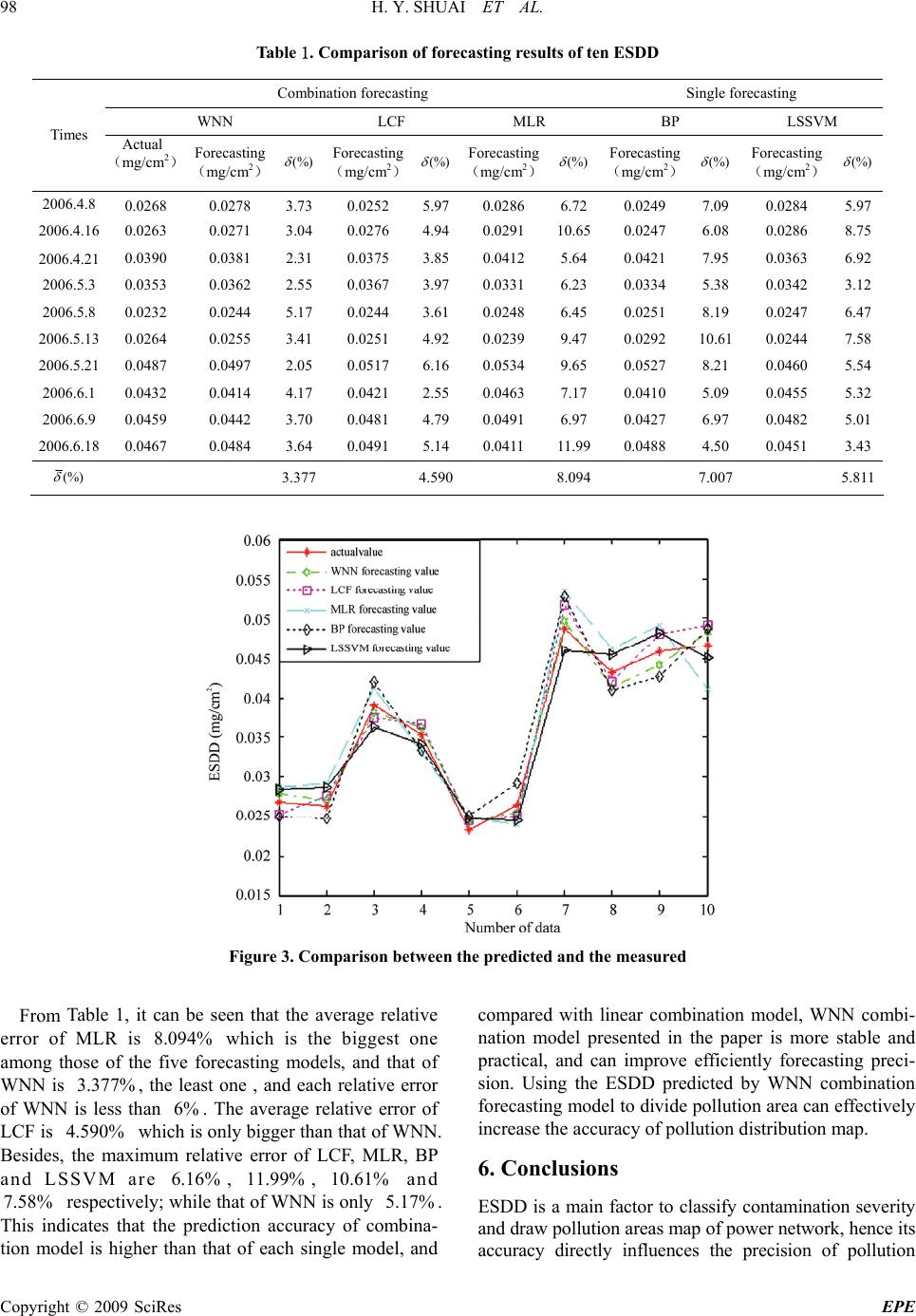 H. Y. SHUAI ET AL. Copyright © 2009 SciRes EPE 98 Table 1. Comparison of forecasting results of ten ESDD Combination forecasting Single forecasting WNN LCF MLR BP LSSVM Times Actual (mg/cm2) Forecasting (mg/cm2) (%) Forecasting (mg/cm2)(%) Forecasting (mg/cm2)(%) Forecasting (mg/cm2)(%) Forecasting (mg/cm2) (%) 2006.4.8 0.0268 0.0278 3.73 0.0252 5.970.0286 6.720.0249 7.09 0.0284 5.97 2006.4.16 0.0263 0.0271 3.04 0.0276 4.940.0291 10.650.0247 6.08 0.0286 8.75 2006.4.21 0.0390 0.0381 2.31 0.0375 3.850.0412 5.640.0421 7.95 0.0363 6.92 2006.5.3 0.0353 0.0362 2.55 0.0367 3.970.0331 6.230.0334 5.38 0.0342 3.12 2006.5.8 0.0232 0.0244 5.17 0.0244 3.610.0248 6.450.0251 8.19 0.0247 6.47 2006.5.13 0.0264 0.0255 3.41 0.0251 4.920.0239 9.470.0292 10.61 0.0244 7.58 2006.5.21 0.0487 0.0497 2.05 0.0517 6.160.0534 9.650.0527 8.21 0.0460 5.54 2006.6.1 0.0432 0.0414 4.17 0.0421 2.550.0463 7.170.0410 5.09 0.0455 5.32 2006.6.9 0.0459 0.0442 3.70 0.0481 4.790.0491 6.970.0427 6.97 0.0482 5.01 2006.6.18 0.0467 0.0484 3.64 0.0491 5.140.0411 11.990.0488 4.50 0.0451 3.43 (%) 3.377 4.590 8.094 7.007 5.811 Figure 3. Comparison between the predicted and the measured compared with linear combination model, WNN combi- nation model presented in the paper is more stable and practical, and can improve efficiently forecasting preci- sion. Using the ESDD predicted by WNN combination forecasting model to divide pollution area can effectively increase the accuracy of pollution distribution map. From Table 1, it can be seen that the average relative error of MLR is 8.09 which is the biggest one among those of the five forecasting models, and that of WNN is , the least one , and each relative error of WNN is less than . The average relative error of LCF is which is only bigger than that of WNN. Besides, the maximum relative error of LCF, MLR, BP and LSSVM are 6.16 , , and respectively; while that of WNN is only . This indicates that the prediction accuracy of combina- tion model is higher than that of each single model, and 4% 6% % 3.377% 4.590% 11.99% 10.61% 5.17.58% 7% 6. Conclusions ESDD is a main factor to classify contamination severity and draw pollution areas map of power network, hence its accuracy directly influences the precision of pollution 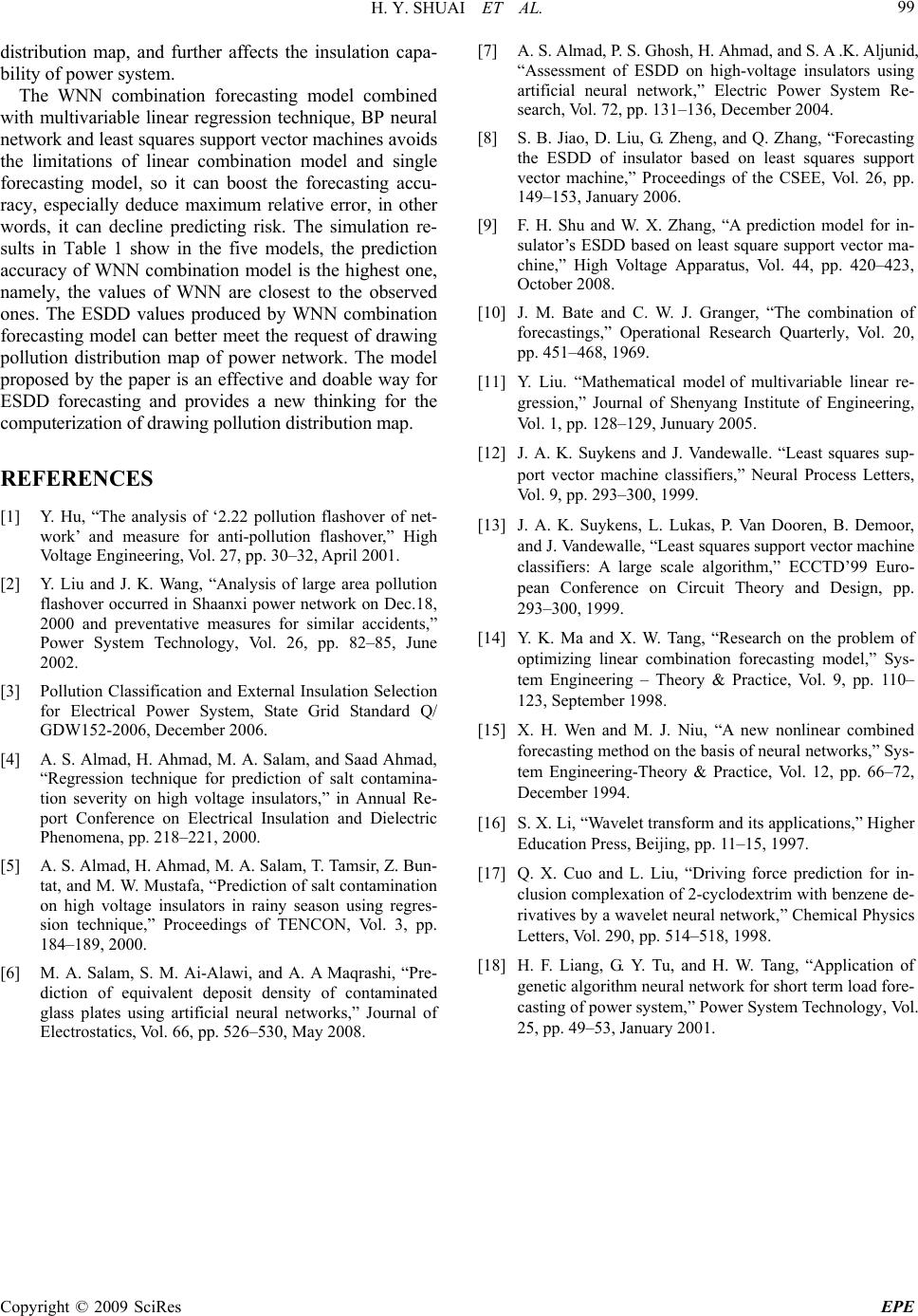 H. Y. SHUAI ET AL. 99 distribution map, and further affects the insulation capa- bility of power system. The WNN combination forecasting model combined with multivariable linear regression technique, BP neural network and least squares support vector machines avoids the limitations of linear combination model and single forecasting model, so it can boost the forecasting accu- racy, especially deduce maximum relative error, in other words, it can decline predicting risk. The simulation re- sults in Table 1 show in the five models, the prediction accuracy of WNN combination model is the highest one, namely, the values of WNN are closest to the observed ones. The ESDD values produced by WNN combination forecasting model can better meet the request of drawing pollution distribution map of power network. The model proposed by the paper is an effective and doable way for ESDD forecasting and provides a new thinking for the computerization of drawing pollution distribution map. REFERENCES [1] Y. Hu, “The analysis of ‘2.22 pollution flashover of net- work’ and measure for anti-pollution flashover,” High Voltage Engineering, Vol. 27, pp. 30–32, April 2001. [2] Y. Liu and J. K. Wang, “Analysis of large area pollution flashover occurred in Shaanxi power network on Dec.18, 2000 and preventative measures for similar accidents,” Power System Technology, Vol. 26, pp. 82–85, June 2002. [3] Pollution Classification and External Insulation Selection for Electrical Power System, State Grid Standard Q/ GDW152-2006, December 2006. [4] A. S. Almad, H. Ahmad, M. A. Salam, and Saad Ahmad, “Regression technique for prediction of salt contamina- tion severity on high voltage insulators,” in Annual Re- port Conference on Electrical Insulation and Dielectric Phenomena, pp. 218–221, 2000. [5] A. S. Almad, H. Ahmad, M. A. Salam, T. Tamsir, Z. Bun- tat, and M. W. Mustafa, “Prediction of salt contamination on high voltage insulators in rainy season using regres- sion technique,” Proceedings of TENCON, Vol. 3, pp. 184–189, 2000. [6] M. A. Salam, S. M. Ai-Alawi, and A. A Maqrashi, “Pre- diction of equivalent deposit density of contaminated glass plates using artificial neural networks,” Journal of Electrostatics, Vol. 66, pp. 526–530, May 2008. [7] A. S. Almad, P. S. Ghosh, H. Ahmad, and S. A .K. Aljunid, “Assessment of ESDD on high-voltage insulators using artificial neural network,” Electric Power System Re- search, Vol. 72, pp. 131–136, December 2004. [8] S. B. Jiao, D. Liu, G. Zheng, and Q. Zhang, “Forecasting the ESDD of insulator based on least squares support vector machine,” Proceedings of the CSEE, Vol. 26, pp. 149–153, January 2006. [9] F. H. Shu and W. X. Zhang, “A prediction model for in- sulator’s ESDD based on least square support vector ma- chine,” High Voltage Apparatus, Vol. 44, pp. 420–423, October 2008. [10] J. M. Bate and C. W. J. Granger, “The combination of forecastings,” Operational Research Quarterly, Vol. 20, pp. 451–468, 1969. [11] Y. Liu. “Mathematical model of multivariable linear re- gression,” Journal of Shenyang Institute of Engineering, Vol. 1, pp. 128–129, Junuary 2005. [12] J. A. K. Suykens and J. Vandewalle. “Least squares sup- port vector machine classifiers,” Neural Process Letters, Vol. 9, pp. 293–300, 1999. [13] J. A. K. Suykens, L. Lukas, P. Van Dooren, B. Demoor, and J. Vandewalle, “Least squares support vector machine classifiers: A large scale algorithm,” ECCTD’99 Euro- pean Conference on Circuit Theory and Design, pp. 293–300, 1999. [14] Y. K. Ma and X. W. Tang, “Research on the problem of optimizing linear combination forecasting model,” Sys- tem Engineering – Theory & Practice, Vol. 9, pp. 110– 123, September 1998. [15] X. H. Wen and M. J. Niu, “A new nonlinear combined forecasting method on the basis of neural networks,” Sys- tem Engineering-Theory & Practice, Vol. 12, pp. 66–72, December 1994. [16] S. X. Li, “Wavelet transform and its applications,” Higher Education Press, Beijing, pp. 11–15, 1997. [17] Q. X. Cuo and L. Liu, “Driving force prediction for in- clusion complexation of 2-cyclodextrim with benzene de- rivatives by a wavelet neural network,” Chemical Physics Letters, Vol. 290, pp. 514–518, 1998. [18] H. F. Liang, G. Y. Tu, and H. W. Tang, “Application of genetic algorithm neural network for short term load fore- casting of power system,” Power System Technology, Vol. 25, pp. 49–53, January 2001. Copyright © 2009 SciRes EPE
|